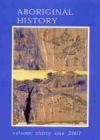Abstract
'This paper provides excerpts from (the source document on difficult-to-read carbon copy) Squadron Leader Donald Thomson's official submission in April 1943. There are 71 pages of report and many appendices. The report is repetitious, and the appendices frequently contain material already discussed. As the central concern of Aboriginal History is with Aboriginal people, I have edited the closely typed manuscript. Those sections which are reproduced include those which explain the background to this remarkable enterprise, or are necessary to the understanding of activities, and particularly all sections which refer to the participation of Aboriginal men and the one Torres Strait Islander enlisted man. I have indicated those sections where omissions were made, which sometimes are extensive. The final text has been reduced to fewer than 30,000 words from probably twice that length. It is significant that Thomson's participation in a scheme to organise Aboriginal warriors in the defence of the northern coast began in June 1941, five months before Japan bombed Pearl Harbour. It indicates military concern for the defence of the north and the expectation of a Japanese landing once hostilities commenced. Because the plan was implemented before the bombing of Darwin in February 1942, its background is reproduced here.' (Source: Abstract)
 6226539212483389006.jpg
6226539212483389006.jpg


